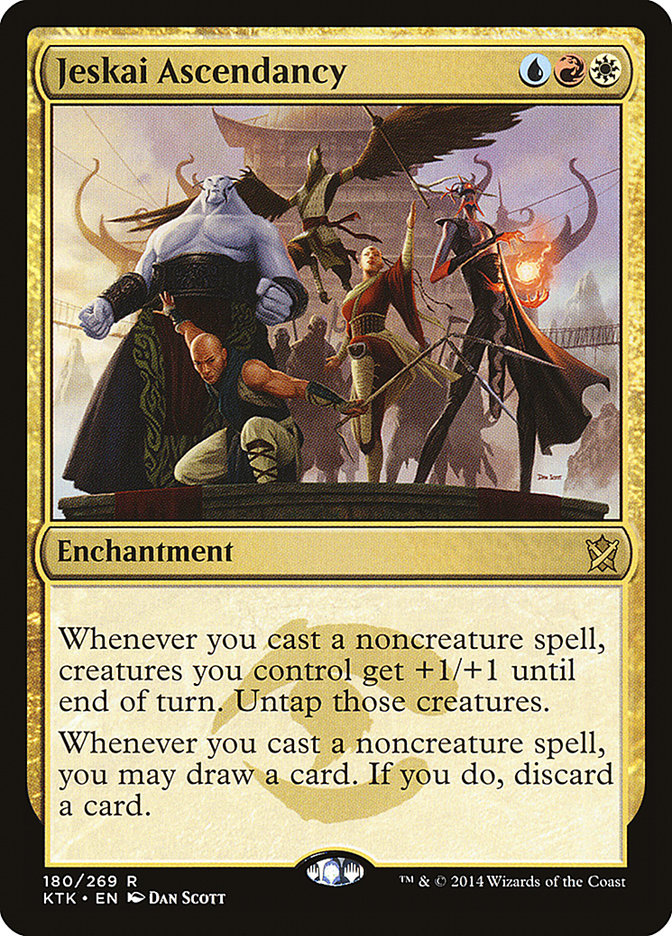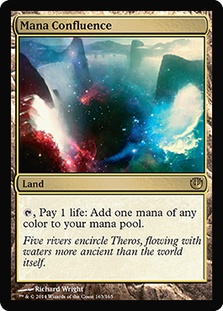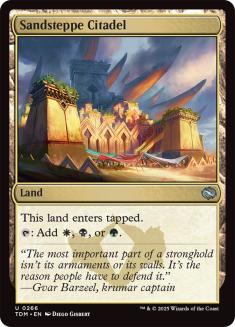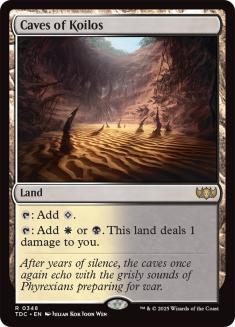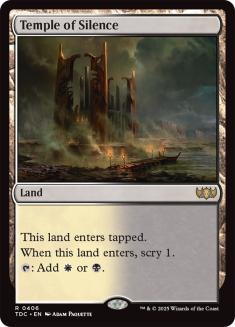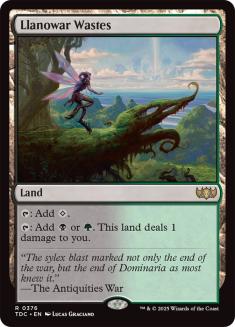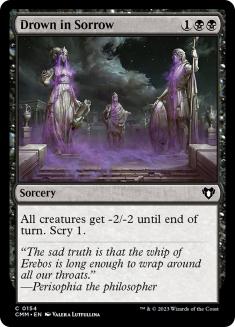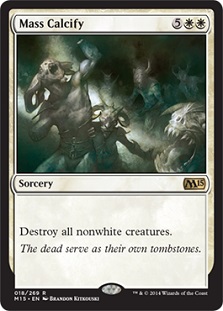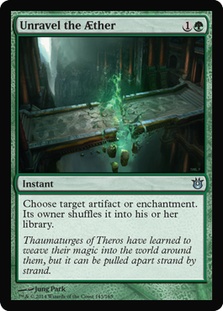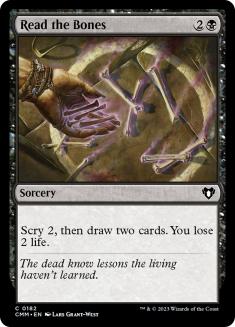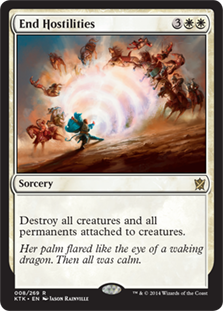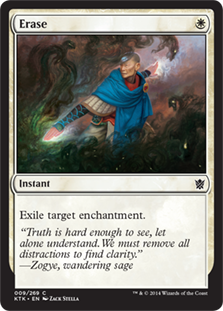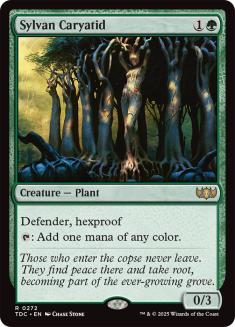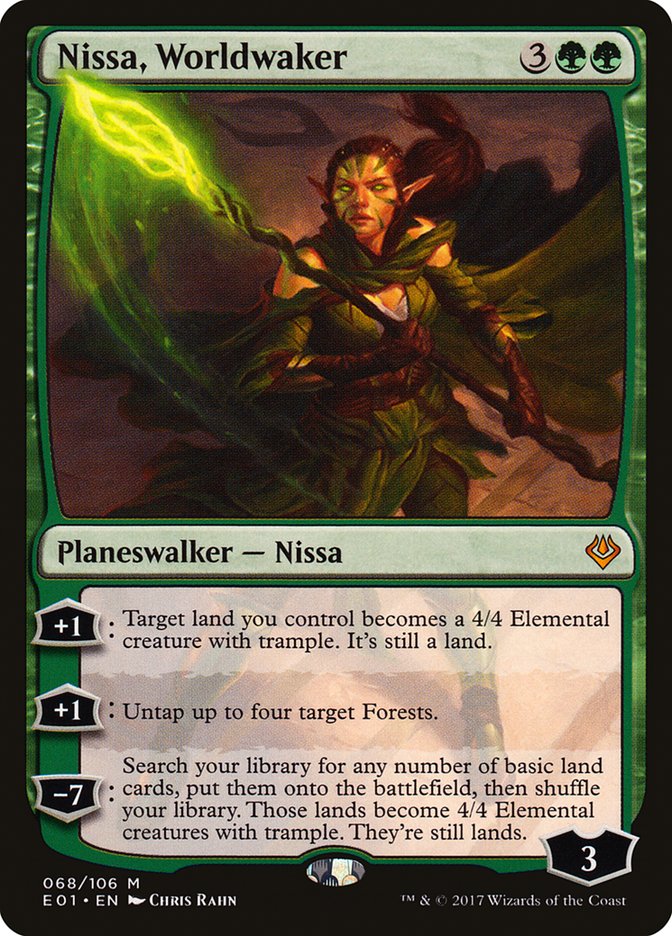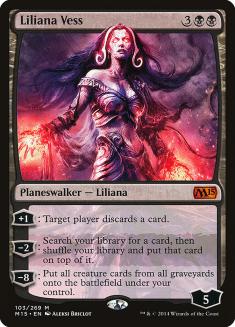A format can have a best deck and still be dynamic.
Besides, how good the games are to play is also a completely different question.
Khans of Tarkir Standard is legitimately incredible. This format might seriously be one of the greatest Standard formats of all-time. It’s not that there
are 42 tier 1 decks. That’s not what makes a format good (nor possible).
The games in this format are so good! This isn’t to say people don’t get mana screwed, because they do sometimes. The mana is pretty great though. Everyone
has access to great manabases, whether they want consistency (like Temples and tri-lands) or speed (fetchlands and painlands), yet mana isn’t so broken
that all the decks blur together (like vivid lands + Reflecting Pool or fetchlands + shocklands).
The games themselves involve tons of meaningful decisions that actually impact the game. It’s not that tons of complexity has been dropped on the game
bombarding us with bookkeeping tasks. It’s that the decision trees have been pruned and cultivated, so that both players are making tons of decisions that
actually matter.
● Do you scry this card to the bottom?
● Attack them or their planeswalker?
● What order do you play your land in?
● What card do you take with Thoughtseize?
● Courser of Kruphix gives both players so much information, so what do you do with that info?
● When do you play your fetchlands and Temples while you have a Courser out?
● What do you play turn 3, the Rabblemaster or the Mantis Rider?
● Which planeswalker ability do you use this turn?
● Which mode on that Charm?
● Saving mana for Knuckleblade’s abilities or casting another creature?
● Play around Abzan Charm and Utter End, or Murderous Cut and End Hostilities?
● How many creatures attack, and how many stay home?
● Is it worth throwing away a creature to trigger raid?
● If they make a losing attack, they have to have Abzan Charm, so how do you block?
● Since they could have Abzan Charm, you can’t block, but maybe they are just bluffing since they know you know this, so now what?
● Is their morph a Rattleclaw Mystic or a Sagu Mauler?
● They have a Perilous Vault out. Now what?
● Should you use your one counter on that, or save it?
● Which two cards do you keep with Dig Through Time?
● How much do you delve for, now that you mention it?
● What’s your sideboard plan this game? Now, how about the next game, after they saw that sequence of cards?
● They play Jace’s Ingenuity, so can you make them discard to handsize by not casting anything for a few turns?
● How do you want to fight that Ashcloud Phoenix?
● How do you want to use that Polukranos, World Eater?
The list literally goes on and on, and we haven’t even gotten to the deckbuilding decisions, which are also very deep and interesting. I can’t remember
ever playing a format with this much depth in the areas of the game that have the broadest appeal. Don’t get me wrong, it was a blast grinding out the
resource management battles years ago that capitalized on the imbalance in understood Magic strategy, but players are not so innocent now.
Besides, the old days have a less compelling distribution of decision relevance. It used to be that the most important decisions were so important, you
would battle for a long time making relatively easy decisions (once you were good enough to know the right answer), and look for someone to make one wrong
and lose (or eventually variance breaks the tie).
Now, the decisions are so much murkier and speculative, you can’t always know the right play, even in retrospect. As a result, everyone is making more
plays that are less than perfect, however, they are not so punishing as to outright lose you the game when you are on the wrong side of it. You lose
percentage and the game goes on.
Mirror matches have often been less than great in Magic’s history. Blue mirror matches have often been pretty solid, but playing non-Blue mirror matches
can be a very harrowing experience. This format though, even the Abzan mirror, the Mardu midrange mirror, the G/R Monsters mirror, the games are pretty
good.
My mind is seriously blown. Maybe it’s just a phase and this format will get bad in a few weeks. I don’t know. I mean, maybe it’s randomly on the high end
of qualities of format, but maybe it is indicative of a major step forward in Magic design. It has happened a number of times before:
● Alpha
● Ice Age
● Mirage
● Tempest
● Ravnica
● Zendikar
● Innistrad
● Invasion
I haven’t been going to that many Grand Prix lately, partially because formats get old. This format, however, this format has me looking at the schedule to
find every possible Standard GP and Open Series event I might be able to hit. The format is just too awesome.
The funny thing is, the Limited format is awesome too. I do a lot of drafts before Pro Tours to prepare for them. I’m usually done with the format after
the Pro Tour, having already had my fill twenty drafts in, or whatever. This format though, I feel like I haven’t even scratched the surface. It’s not just
how much more there is to explore and do, it’s also how enjoyable it is to be doing. I am sympathetic to those that find it too hard, as the format is the
most hardcore Limited format in years. I know it’s really hard for me. It sure is fun though. It’s hard to play perfect, but it’s not hard to just play and
have fun.
Yeah, Khans of Tarkir has some questionable cards in it. I hate fetchlands as much as the next guy, but they do have sweet deckbuilding implications, and
they do make for interesting gameplay, shuffling time aside. It’s really not even that bad in Standard, when you only play so many. The problem is in
formats where more than half your lands are fetches.
Treasure Cruise and especially Dig Through Time are a bit much, but so far, I don’t think they have caused problems in Standard. I would prefer Dig be a
little less good and other blue cards be a little more good, but it is not ruining the format by any means. Yes, both cards are going to cause serious
problems in Modern, but Modern could use a shake-up. Pretty good chance one or both is banned in six months, but people are so focused on Jeskai
Ascendancy, hopefully we’ll get to play a Modern Pro Tour with broken blue card drawers. Why are they so broken in Modern?
1. Fetchlands, cantrips, and efficient one-cost spells make them super cheap fast and easy.
2. Saving mana in Modern is worth more than saving mana in Standard, since every mana you save is converted into game winning advantages more efficiently.
3. Drawing extra cards or tutoring is worth more than it is in Standard, since the cards in your deck are more powerful and have better synergy.
I don’t think printing a couple cards that might need to be banned in Modern is really that big a problem, or even a problem at all. I think Modern would
get boring if it didn’t get shaken up.
Of course, that doesn’t excuse Jeskai Ascendancy.
I haven’t played Modern enough recently to know, but I wouldn’t be surprised if Treasure Cruise and Dig Through Time were actually stronger cards (I would
guess so). However, Jeskai Ascendancy will more certainly be banned and first. Modern is supposed to be a format where people aren’t consistently winning
before turn 4. Yes, Infect can, but you can also just block their creatures, so they aren’t really.
Jeskai Ascendancy doesn’t just kill turn 3 the majority of the time with an unblockable combo kill, it also kills turn 2 some of the time. It’s seriously
not even close to an acceptable speed for Modern. There is a lot of disagreement over how good it is once the format adjusts to it, but there is no
disagreement at all regarding the speed of the deck. Modern is one of the formats for the World Championships in December. What is that going to look like?
I know Jeskai Ascendancy has skyrocketed in value, but think this one through. The card is not going to be legal long (at least in Modern). Maybe it’s
playable in Legacy, and it’s still a thing in Standard (though hopefully it doesn’t get actually good).
Jeskai Ascendancy is the biggest mistake in Khans of Tarkir, in terms of being so clearly the wrong thing for little gain. I just wish there would be a
control-F for the word “untap” before sets get shipped. It should not be okay to ship cards with that word without testing them unless they truly are worse
versions of existing cards, so that their effects are somewhat known.
Anyway, this Standard format is sweet, so I flew to LA and played in the Grand Prix this past weekend. I played Abzan Midrange, which I think is definitely
the best deck. You can make Abzan beat any three things you want (though you can’t beat everything at the same time), it has the best sideboard cards, and
its raw card quality is the highest.
Despite there being a best deck, you can beat it if you want to. If you anticipate what the Abzan decks will look like, you can play a deck that is not one
of the decks they are set up to beat. For instance, both last week at the Pro Tour and this week in LA, most Abzan decks weren’t aiming at G/R Monsters. It
was well-known that G/R Monsters wasn’t a real deck because of getting crushed by Green Devotion, so who cares? Right?
Except that Green Devotion didn’t do well in Honolulu and was looking real bad this week. One of its best match-ups (Abzan) was now one of its worst since
people figured out how to mix sweepers, card draw, and efficient one-for-ones. With Green Devotion’s numbers plummeting and Abzan decks everywhere to prey
on, G/R Monsters came out to play, including eventual champion, Daniel Scheid, and Brian Kibler (whose Temur Monsters deck carried him to a top 16 finish).
Creatures (25)
- 1 Hornet Queen
- 4 Elvish Mystic
- 3 Polukranos, World Eater
- 4 Sylvan Caryatid
- 4 Stormbreath Dragon
- 4 Courser of Kruphix
- 2 Genesis Hydra
- 2 Rattleclaw Mystic
- 1 Ashcloud Phoenix
Planeswalkers (5)
Lands (23)
Spells (7)

The Abzan decks will have to evolve, and they will. However, that will lead to vulnerabilities somewhere else. Of course, G/R Monsters wasn’t Abzan’s only
weakness, this weekend. Brad Nelson and a bunch of other players concocted a Mardu Midrange deck with a more token-centric theme that managed to not only
generally do well on the weekend, it consistently beat Abzan.
Creatures (15)
Planeswalkers (4)
Lands (25)
Spells (16)

The biggest improvements Brad and company made to Mardu were the use of Hordeling Outburst instead of Stoke the Flames, and Wingmate Roc instead of
Stormbreath Dragon or more Sarkhans. While being very threat-based game 1, they have the tools to sideboard into a much more controlling midrange deck
games 2 and 3.
One of my losses this weekend was to Valentin Mackl playing the same list as Brad, and while I was satisfied with my in-game play, for the most part, I
sideboarded totally wrong, not knowing their list or their plan. While I would like to play the matchup again knowing what I know now, it does go to show
that one of the best ways to beat Abzan is to hit them with something they haven’t seen before or that tricks them in some way.
Despite not taking the top spot, it was another great weekend for Abzan, with four in the top 8 and more in the top 16. Jeskai is good, but is starting to
lag further behind. That said, there were some interesting Jeskai innovations this weekend, like Tom Martell’s maindeck Prognostic Sphinx. Playing all burn
just doesn’t work anymore, with the most popular deck in the format playing twelve lifegain cards maindeck. However, finding some way to take the strategy
in a different direction can go a long way, and the deck does have good card quality (Dig Through Time, Mantis Rider, Jeskai Charm, Stoke the Flames). I
wonder when Wingmate Roc makes it into Jeskai?
I liked the list I played in Honolulu, but I liked champion Ari Lax’s list even better, manabase aside. I didn’t have time to test, as my flight into LA
got delayed in Honolulu for nine and a half hours, getting me in around 6am Saturday. As a result, I just started from Ari’s list and made some changes as
I felt appropriate. He and his testing group did a really remarkable job, and honestly, after looking at a lot of Abzan lists, I really do think theirs was
the best in the entire tournament.
Here’s the list I registered for GP LA:
Creatures (14)
Planeswalkers (6)
Lands (25)
Spells (15)
Sideboard

The most dramatic change was a restructuring of the manabase. I absolutely loved their list, and their manabase definitely works, but I prefer the same
manabase I ran last week. For reference, here is their manabase:
3 Forest
2 Plains
They also used two Elvish Mystics on top of the four Caryatids. I don’t love Elvish Mystic in the format, but I wouldn’t fault someone for wanting one.
That said, I cut the two they had for a twenty-fifth land and a Read the Bones (which is pretty good at fixing your mana). Of course, this left me a little
slower, but I wanted the fourth Hero’s Downfall anyway, so I cut the second Ajani, Mentor of Heroes, which looked like the weakest card in the deck to me
(a decision I was happy with, in retrospect). The Read the Bones helped make up for the loss of card draw from losing a walker.
As for the lands themselves, I don’t love Mana Confluence in slower, more controlling builds like this. There is just too much burn, and while one is not
that bad, I would rather avoid them at the moment. I also disagree with nine being the optimal number of tapped lands. Obviously, it partially depends on
the strength of your tapped lands, but Temples are some of the strongest tapped lands in the game’s history. Tri-lands are really strong, but Temples are
even stronger.
Compared to Ari’s manabase, I went:
Out:
In:
Having a twenty-fifth land means I get to play less three-color lands and still have the same amount of mana symbols from my lands (which is good, because
Mana Confluence is painful right now, and Temples are better than tri-lands). Not playing Elvish Mystic also means I can get away with seventeen green
mana, instead of eighteen. This extra symbol is turned into a black mana, as I want to more reliably Bile Blight and Drown in Sorrow early in some matchups
where I am planning on boarding out Sylvan Caryatid (a technique I don’t think most people employ, yet).
As listed above, the only other changes to the maindeck were the replacing the two Elvish Mystics and an Ajani, Mentor of Heroes with a Read the Bones and
a Hero’s Downfall (plus the land changes). As for the sideboard, there are a couple of tweaks, but I liked most of what they were doing. The main thing is
that I wanted access to some Read the Bones, as it is fantastic against control and Abzan, both of which I expected to increase in popularity.
Additionally, I sideboard Sylvan Caryatid out in some matchups, including Abzan and Control, so having my sideboard plan against them naturally fix my mana
helped alleviate potential mana problems after board.
Compared to their sideboard, my changes were:
Out:
In:
I loved their sideboard, but I wanted to fit a Read the Bones, so I compacted the Mass Calcify and End Hostilities. End Hostilities is a worse Drown in
Sorrow in those matchups and a worse Mass Calcify in some others (like against Green Devotion), however, it is still good at both. I also expected Green
Devotion to be on the decline, and my sideboard strategy regarding which cards to bring in and out is a little unorthodox. For instance, I frequently board
out a Wingmate Roc or two on the draw. Additionally, I often want to bring End Hostilities in against Abzan (a strategy most others don’t use heavily),
whereas Mass Calcify is unplayable in the mirror.
As for the Erase over Unravel, I simply followed Ari’s advice from his column, which worked out fine. I could see it going either way in the future, it
just depends on how many people you expect to play Perilous Vault. In general though, I liked saving the mana.
Moving forward, the card I am most unsure of maindeck is Ajani, Mentor of Heroes. It was decent, but I am not sure it is the best possible. Interestingly,
Liliana Vess really overperformed for me. I could totally imagine playing her maindeck (though I still don’t want a second one).
I never actually Duneblasted all weekend. I drew it some, but I either was already winning, or it wasn’t cheap enough to help. I’m not sure if I am going
to move away from it, but it is definitely a potential chopping block card.
Having access to at least two Utter End, two Murderous Cut, two Drown in Sorrow, and then the Bile Blights, Abzan Charms, and Hero’s Downfalls was great.
It gave me all the flexibility I needed, though if G/R Monsters is on the rise, more change will be needed to combat them. I’m not sure the right mix yet,
but I want to try more Murderous Cuts and possibly Despise again.
Some observations on playing Abzan:
● When in doubt, lead with the tri-land before the Temple. It is sometimes right to Temple first, but most of the time, the tri-land first means you have
more information to make your scry decision (both an extra card you have drawn, and an extra turn of opponent’s actions to assess). The time to play the
Temple is when you are specifically trying to find a card to play on curve. For instance, if you have a tri-land, a Temple, and two untapped lands in hand
to choose from turn 2 and no three-cost spell in your hand, if you already have perfect colors, you may want to play the Temple and increase the chances of
finding a three-cost card to play on curve.
● I like sideboarding out all of my Caryatids against the mirror, Control, and Green Devotion. Whenever you board out the Caryatids, you need both Read the
Bones to make the mana work in this build.
● Kill your opponent’s creatures before they attack if they have white mana. No need to let your opponent trigger the raid on their Wingmate Roc.
● It is tempting to board out Thoughtseize against Jeskai. Don’t. You need that info.
● When playing against Jeskai, kill their creatures rather than advance your board. The way they snowball is by any of their threats living.
● When you have a bunch of land in your hand and finally miss on Courser from the top, play the fetchland in your hand first if you can. That way, the next
time you miss you can shuffle if you want before playing a land and have another shot at hitting.
● You can play a Temple off the top of your deck, while you have a Courser, and with the scry trigger on the stack, sacrifice a fetchland if you see the
top card is a card you don’t want. You can also Abzan Charm to draw two in response if it is a card you want.
● When playing against control, don’t just keep running your threats into their answers. If you do, they will eventually just Jace’s Ingenuity and Dig
Through Time to refill. Actually, this one deserves some elaboration…
The control decks have a secret weakness. They can only hold seven cards in hand. If you just sit there, they eventually only draw land 45% of the time.
Most of them have nothing they can do proactive until ultra late in the game, save maybe a little discard. Even that, however, doesn’t really change the
dynamic. If you don’t play stuff for them to kill, eventually they have to discard to handsize.
This is not to say you do nothing the whole game. They aren’t set up in the early turns, and you can often get a threat ahead of them and get some
advantage going. Thoughtseize is crucial here, letting you know exactly what they are and are not capable of. Rather than walk face first into counters
though, you can wait until their end step and draw two with Abzan Charm.
Once you are at the middle point of the game, hit them with one threat until they deal with it. If you are both lower on cards in hand, keep playing your
threats out until one sticks. If you are both high on cards, however, be patient. You’ve got a lot of bad cards and they have more card draw. However, if
you just sit around, you can stockpile a hand full of cards and build the mana to cast them.
Meanwhile, your opponent can’t fill their graveyard to Dig, since you aren’t casting anything. They also can’t just Ingenuity, as it would lead to them
discarding. If you get stuck on eight cards in hand, you usually don’t want to discard, but generally, you want to try to sculpt a hand, then Thoughtseize
them. It is the most mana efficient way to begin a big turn. It also beats things like Disdainful Stroke and Nullify, which are totally reasonable cards
they might be sitting on.
Part of what you’re doing is trying to figure out what cards are in their hand. Thoughtseize makes this easy, but sometimes you have to do it the hard way.
It’s a logic puzzle, solving what cards would make sense to be in their hand, based on the decisions they have made.
If you have ten mana and eight cards in hand, you might cast a Siege Rhino to test the waters. If they let it stick, maybe you just ship the turn instead
of walking face first into a counter or a Perilous Vault. Remember, they have to have something in their hand. If they kill your creature, play another one
next turn.
Additionally, if they try to win with Pearl Lake Ancient, you can actually do some serious damage to it with Hero’s Downfall, Abzan Charm, Utter End, and
Elspeth. Remember, even if they Bile Blight their own Pearl Lake Ancient in response to Elspeth, prowess means it dies (an interaction I missed in the
Grand Prix, which fortunately did not end up costing me the match).
A general rule of thumb against control is that you are looking for threats. Other than the very early stages of the game, you generally want to scry away
lands and Downfalls, and keep any threat at all. What you really want are Abzan Charms and Thoughtseize, but these are just tools for trying to end up with
one more threat than they have an answer for.
Against U/B Control, I sideboard:
Out:
In:
I would like to have another proactive card to bring in here, as I would kind of rather have three Hero’s Downfalls, but it’s not the end of the world.
Wingmate Roc is the worst threat here, but it is still fine. It eats a removal spell or a counterspell like everything else.
I ended up 12-2-1 in the Grand Prix, finishing ninth on breakers. My wins were against:
● 2 Jeskai Aggro
● 2 Abzan Midrange
● 2 Abzan Aggro
● 1 Abzan Reanimator
● 1 Mardu Midrange
● 1 U/B Control
My two losses were against a Jeskai Aggro and a Mardu Midrange. My draw was, not surprisingly, against U/W Control.
I definitely recommend Abzan Midrange going forward. I think the cards are naturally good against Jeskai and Abzan Aggro, and Steve Rubin and Ari Lax’s
Abzan list is good enough against control. I think the next step is figuring out how to tweak the deck to get some percentage back against G/R Monsters,
which might involve Arbor Colossus, Murderous Cut, and maybe Despise.
The biggest thing I would recommend is practicing a lot. There is so much play to this format, so get as much experience as you can, whatever deck you
play. After each game, ask yourself what you learned from that game. It’s not enough to just get in reps. Be mindful of what you are learning, more
focused. This format is intense, so give it the focus it demands.
The next Standard Grand Prix is unfortunately just a couple days before the World Championships in France, so I suspect I may have to skip it, but if there
is any way to make the timing work and avoid jet lag, I’d love another chance to play before the world championships. You know, there are Open Series
events in Minneapolis and Oakland coming up. I wonder…
Major props to Ari Lax, Steve Rubin, and everyone else that worked on this build. It’s nice to see the best deck in the tournament actually win and to see
one of the best players to never top 8 a Pro Tour not only breakthrough, but break all the way through and take it home.
Nice work.

